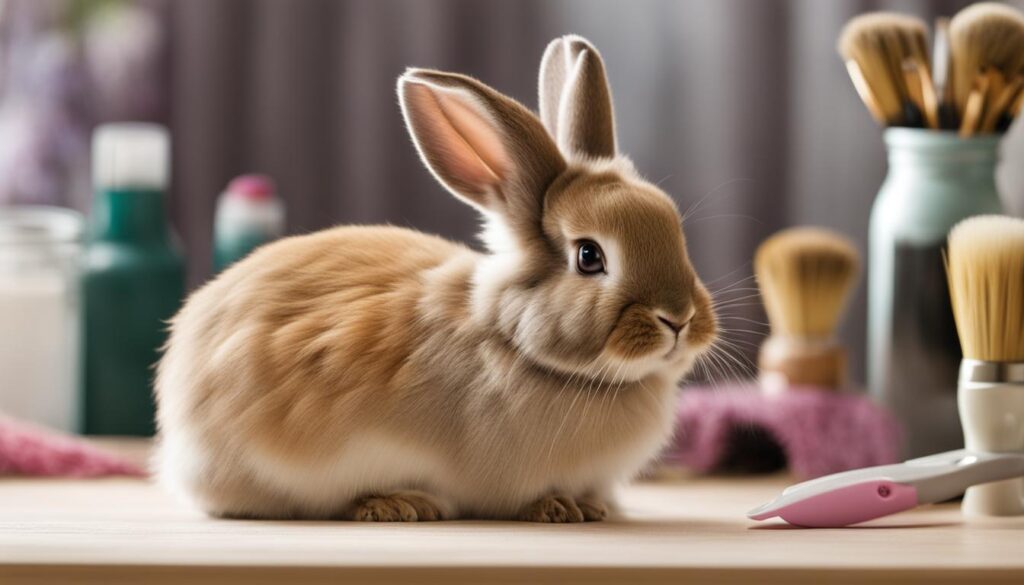In this article, we will provide you with essential tips and guidance on how to groom your rabbit for optimal health and cleanliness. Regular grooming is crucial for rabbits to ensure their well-being and happiness. Below, you will find valuable information on rabbit grooming, including grooming tips and techniques.
Whether you are a new rabbit owner or have been caring for rabbits for years, understanding the best practices for rabbit grooming is essential. By following these tips, you can keep your bunny healthy, prevent common issues like hairballs and overgrown nails, and strengthen the bond between you and your furry friend.
Stay tuned as we explore the importance of grooming, the necessary tools, brushing techniques, nail trimming, ear cleaning, and more. Let’s dive into the world of rabbit grooming and discover how you can provide the best care for your beloved bunny.
Why Grooming is Important for Rabbits
Grooming plays a crucial role in maintaining the health and happiness of rabbits. Regular brushing helps remove loose hair, prevent hairballs, and reduce the risk of matted fur. It also allows for early detection of any underlying health issues, such as skin problems or parasites. Nail trimming is important to prevent discomfort and abnormal gait. Scent gland cleaning helps keep rabbits odor-free and prevents build-up of dirt and bacteria. Regular ear cleaning helps prevent ear infections. Overall, grooming promotes good hygiene and improves the overall well-being of rabbits.
When you groom your rabbit, you not only maintain their physical appearance but also ensure their overall health. Brushing their fur helps remove loose hair, preventing them from ingesting it and forming hairballs in their digestive system. This is especially important for rabbits with long hair, as they are more prone to hairballs. Additionally, regular brushing allows you to spot any skin problems, such as irritation or parasites, at an early stage.
Nail trimming is another essential aspect of grooming. Overgrown nails can cause discomfort for rabbits and even lead to more serious issues like abnormal gait or injury. By keeping their nails short and well-maintained, you can prevent these problems and ensure your rabbit’s mobility and comfort.
Cleaning the scent glands and ears of your rabbit also contributes to their well-being. Scent glands, located around their chin and anus, can produce strong odors if not cleaned regularly. By keeping these areas clean, you can prevent any unpleasant smells and maintain your rabbit’s hygiene. Cleaning their ears helps prevent infections, which can be painful and potentially lead to more severe health issues if left untreated.
Overall, regular grooming is essential for your rabbit’s health and happiness. It not only helps prevent common problems like hairballs, overgrown nails, and infections but also strengthens the bond between you and your furry friend. By taking care of their grooming needs, you are ensuring their overall well-being and providing them with the best possible quality of life.
Table: Benefits of Rabbit Grooming
| Benefits | Description |
|---|---|
| Removes loose hair | Prevents hairballs and reduces the risk of matted fur |
| Early detection of health issues | Allows for spotting skin problems or parasites at an early stage |
| Prevents discomfort | Regular nail trimming prevents abnormal gait and injury |
| Promotes good hygiene | Cleaning scent glands and ears prevents odor and infections |
Tools for Rabbit Grooming
Grooming your rabbit is essential for maintaining their health and well-being. To effectively groom your furry friend, you’ll need a few essential tools. Here are some must-have rabbit grooming supplies:
- Brush or comb: Choose a brush or comb suitable for your rabbit’s coat type. A slicker brush or shedding brush works well for most rabbits.
- Flea comb: This comb is useful for removing any fleas or flea dirt that may be present on your rabbit’s fur.
- Nail clippers: Small pet nail clippers are necessary for trimming your rabbit’s nails regularly.
- Bath towel: Have a clean bath towel on hand to handle your rabbit during grooming sessions.
- Q-tips and cotton balls: These are useful for cleaning your rabbit’s ears and scent glands.
- Rabbit first aid kit: It’s always a good idea to have a first aid kit specifically for your rabbit in case of any grooming-related accidents.
By having these tools readily available, you’ll be well-equipped to keep your rabbit looking and feeling their best. Remember, grooming should be a positive experience for both you and your rabbit, so approach it with patience and gentle care.
How to Brush a Rabbit’s Fur
Grooming your rabbit’s fur is an integral part of maintaining their overall health and well-being. Regular brushing helps remove loose hair, prevent hairballs, and keep their coat in good condition. Here’s a step-by-step guide on how to brush a rabbit’s fur effectively:
1. Prepare a Comfortable Grooming Area
Find a peaceful and comfortable space where you and your rabbit can relax during the grooming session. Place a towel or soft blanket on a flat surface to provide a cozy and secure environment for your furry friend.
2. Choose the Right Brush or Comb
Select a brush or comb that is suitable for your rabbit’s coat type. Slicker brushes or shedding brushes work well for removing loose hair from rabbits with shorter fur, while rabbits with longer fur may require a comb to gently detangle any mats.
3. Gently Brush in the Direction of Hair Growth
Start by gently brushing your rabbit’s fur in the direction of hair growth. Be extra careful when brushing sensitive areas, such as behind the ears and under the chin, as these are prone to matting. Use short and gentle strokes to avoid pulling or tugging on their fur.
4. Pay Attention to Heavy Shedding Periods
During heavy shedding periods, you may need to brush your rabbit more frequently to prevent excessive fur accumulation and hairballs. Increase the frequency of brushing sessions and be thorough in removing all loose hair from their coat.
Remember to always be gentle and patient with your rabbit during the grooming process. Offer treats and positive reinforcement to make the experience more enjoyable for them. Regular brushing not only helps keep your rabbit’s coat clean and free of mats but also strengthens the bond between you and your furry companion.
| Brush/Comb Type | Coat Type | Best For |
|---|---|---|
| Slicker Brush | Short fur | Removing loose hair |
| Shedding Brush | Short fur | Removing loose hair during shedding season |
| Comb | Long fur | Gently detangling and removing mats |
Nail Trimming for Rabbits
Regular nail trimming is an important part of maintaining your rabbit’s overall health and well-being. Overgrown nails can cause discomfort, affect their ability to walk properly, and even lead to serious health issues. Here’s a step-by-step guide on how to trim your rabbit’s nails safely and effectively:
Gather the necessary tools:
- Nail clippers specifically designed for small pets
- Styptic powder or cornstarch to stop any bleeding
- A clean towel or table to secure your rabbit
Prepare your rabbit:
Find a calm and quiet area where you can comfortably trim your rabbit’s nails. Place a clean towel or table on a stable surface to secure your rabbit and prevent them from wriggling away.
Trimming the nails:
- Gently hold your rabbit’s paw and extend one nail at a time.
- Identify the quick, which is the pink area in the nail. Be careful not to cut into it, as it can cause bleeding and pain.
- Trim just above the quick, taking small, careful cuts.
- If your rabbit’s nails are black and you can’t see the quick, trim a small amount at a time to be safe.
- If there is any bleeding, apply styptic powder or cornstarch to stop it.
Reward and reassure your rabbit:
After each nail trimming session, reward your rabbit with their favorite treat and plenty of praise. This positive reinforcement will help create a positive association with nail trimming and make future sessions easier.
Remember, if you’re unsure or uncomfortable with trimming your rabbit’s nails, it’s always best to consult a veterinarian or a professional groomer who can provide expert guidance and assistance.
Cleaning Your Rabbit’s Ears
Cleaning your rabbit’s ears is an important part of their grooming routine. It helps prevent wax build-up and potential infections, ensuring their ears stay healthy and free from discomfort. To clean your rabbit’s ears, follow these simple steps:
- Gently lift your rabbit’s ears and examine them for any signs of redness, swelling, or discharge. This initial inspection allows you to identify any potential ear problems that may require veterinary attention.
- Take a damp cloth or a soft cotton ball and gently clean the outer side of your rabbit’s ears. Ensure that you don’t go too deep into the ear canal to avoid causing any harm or discomfort to your rabbit.
- Avoid using any cleaning products or solutions not recommended by a veterinarian. These can be harmful to your rabbit’s delicate ears and lead to irritation or other complications.
- If you notice any unusual symptoms or persistent wax build-up, it’s best to consult a veterinarian. They can perform a thorough examination of your rabbit’s ears and provide appropriate treatment if necessary.
By regularly cleaning your rabbit’s ears, you can help maintain their overall hygiene and prevent ear-related issues. Remember to handle your rabbit with care and be gentle during the cleaning process to ensure their comfort and well-being.
| Benefits of Ear Cleaning | Precautions |
|---|---|
|
|
Avoiding Baths for Rabbits
Rabbits are self-cleaning animals and generally do not require regular baths. Bathing can be stressful for rabbits and may lead to health problems. However, there are some situations where a bath may be necessary, such as when a rabbit has a dirty or soiled bottom. In these cases, it’s important to approach bathing with caution to ensure the safety and well-being of your rabbit.
If your rabbit has a poopy butt, it’s best to give them a “butt bath” using a shallow container with warm water and a towel. Gently clean the affected area and dry your rabbit thoroughly afterwards. It’s important to use lukewarm water and avoid getting water in their ears or eyes. Additionally, always ensure that the room is warm and draft-free before attempting a bath.
If your rabbit’s fur gets wet for any reason, such as accidentally spilling water on them, make sure to dry them off immediately. Wet fur can cause hypothermia in rabbits, as they are not able to regulate their body temperature as efficiently as other animals. Use a clean towel to gently dry your rabbit and provide a warm, dry environment for them to recover.
Table: Pros and Cons of Bathing Rabbits
| Pros | Cons |
|---|---|
| Bathing can help with removing dirt or debris from a soiled bottom. | Bathing can cause stress and anxiety for rabbits. |
| A clean rabbit may have a reduced risk of certain health issues. | Rabbits have delicate skin that can be easily irritated by bathing. |
| Bathing can help cool down a rabbit in extreme heat. | Improper bathing techniques can lead to health problems for rabbits. |
If you’re unsure about bathing your rabbit or if they require specialized treatment, it’s best to consult a veterinarian for guidance. They can provide professional advice and recommend alternative methods for maintaining your rabbit’s cleanliness and hygiene.
Other Grooming Considerations for Rabbits
While brushing, nail trimming, and ear cleaning are important aspects of rabbit grooming, there are other considerations to keep in mind. Creating a grooming checklist can help ensure you don’t overlook any essential tasks. Here are some additional grooming considerations for your rabbit:
Checking for Matted Hair
Rabbits with long fur are prone to matting, which can cause discomfort and lead to skin problems. Regularly check your rabbit’s fur for any mats and use a mat splitter or rake to gently work them out. Pay extra attention to areas behind the ears and along the back, as these are common spots for mats to form.
Monitoring Skin Health
Inspect your rabbit’s skin regularly for any sores, open wounds, or signs of infection. Look for redness, swelling, or any unusual lumps or bumps. If you notice any abnormalities, consult a veterinarian for further examination and treatment.
Chin and Scent Gland Cleaning
Rabbits have scent glands around their chin and anus that can become dirty and produce odor. Clean these areas as needed using a damp cloth or cotton ball. Gently wipe away any dirt or build-up to keep your rabbit smelling fresh and prevent infection.
Feet Care
Check your rabbit’s feet regularly for any signs of redness, swelling, or sores. Ensure their living environment provides a clean and comfortable area for them to rest, and consider providing soft resting pads to prevent any discomfort or pressure sores.
| Grooming Consideration | Description |
|---|---|
| Checking for Matted Hair | Inspect your rabbit’s fur for mats and use appropriate tools to gently remove them. |
| Monitoring Skin Health | Regularly examine your rabbit’s skin for sores, wounds, or signs of infection. |
| Chin and Scent Gland Cleaning | Clean the scent glands around your rabbit’s chin and anus to prevent odor and infection. |
| Feet Care | Check your rabbit’s feet for any signs of redness, swelling, or sores. Provide a clean and comfortable environment for them to rest. |
Rabbit Grooming for Different Coat Types
Grooming techniques for rabbits can vary depending on their coat type. Whether you have a long-haired or short-haired rabbit, it’s important to tailor your grooming routine to fit their specific needs.
Grooming Long-Haired Rabbits
Long-haired rabbits, such as Angora breeds, require more frequent brushing to prevent matting and hairballs. Use a slicker brush or shedding brush to gently remove tangles and loose fur. Pay extra attention to areas prone to matting, such as behind the ears and under the chin. In addition to regular brushing, consider trimming their fur to prevent excessive matting and hairball formation. If you’re unsure about trimming their fur, consult a professional groomer for assistance.
Grooming Short-Haired Rabbits
Even though short-haired rabbits don’t have as much fur as their long-haired counterparts, they still benefit from regular brushing. Brushing helps remove loose hair and prevents hairballs. Use a soft brush or grooming mitt to gently brush their coat, following the direction of hair growth. Regular brushing also allows you to bond with your rabbit and monitor their overall health and well-being.
Grooming for Different Rabbit Breeds
Each rabbit breed may have specific grooming requirements. Some breeds, like the Netherland Dwarf or Rex, have shorter, denser fur that may require more frequent brushing. Others, like the Lionhead or Jersey Wooly, have longer fur that needs regular brushing and occasional trimming. Researching the specific grooming needs of your rabbit’s breed can help you develop a grooming routine that keeps them happy and healthy.
| Coat Type | Grooming Needs |
|---|---|
| Long-Haired | Frequent brushing, occasional fur trimming |
| Short-Haired | Regular brushing to remove loose hair |
| Breed-Specific | Research specific grooming requirements for your rabbit’s breed |
By understanding the grooming needs of rabbits with different coat types and breeds, you can ensure that your furry friend stays clean, comfortable, and healthy.
Maintaining a Clean Living Environment for Your Rabbit
Ensuring a clean living environment for your rabbit is crucial for their overall health and well-being. Regularly cleaning your rabbit’s cage or hutch is essential to prevent the build-up of bacteria and parasites. Remove any soiled bedding and disinfect the area to maintain a clean and hygienic space for your rabbit.
Provide fresh bedding material to keep your rabbit comfortable and ensure their litter box or designated toilet area is kept clean. Regularly sweeping or vacuuming the area where your rabbit has free-roaming access will help remove loose fur and dander, maintaining a clean environment. Remember to clean your rabbit’s food and water dishes regularly and ensure they have access to fresh water at all times.
By monitoring your rabbit’s living environment and practicing good hygiene habits, you are taking important steps to promote their health and prevent potential health issues. A clean living environment contributes to a happy and healthy rabbit.
Tips for Maintaining a Clean Living Environment for Your Rabbit
- Regularly clean your rabbit’s cage, removing soiled bedding and disinfecting the area.
- Provide fresh bedding material and keep the litter box or designated toilet area clean.
- Sweep or vacuum the area where your rabbit has free-roaming access to remove loose fur and dander.
- Clean your rabbit’s food and water dishes regularly and ensure they have access to fresh water at all times.
| Area | Cleaning Frequency |
|---|---|
| Cage or hutch | Weekly |
| Litter box or toilet area | Daily |
| Free-roaming area | As needed |
| Food and water dishes | Daily |
Conclusion
Grooming is a vital aspect of maintaining a healthy and happy rabbit. By regularly brushing their fur, trimming their nails, cleaning their ears, and providing a clean living environment, you can ensure your rabbit’s well-being. Not only does grooming promote good hygiene, but it also allows for early detection of any underlying health issues. Taking care of your rabbit’s grooming needs strengthens the bond between you and your furry friend.
By dedicating time and attention to grooming, you contribute to the overall health and longevity of your rabbit. Regular brushing helps remove loose hair, prevent hairballs, and reduce the risk of matted fur. It also allows you to identify any skin problems or parasites early on. Trimming your rabbit’s nails prevents discomfort and abnormal gait, ensuring they can move around comfortably.
In addition to brushing and nail trimming, cleaning your rabbit’s ears and providing a clean living environment are crucial. Regular ear cleaning prevents wax build-up and potential infections, while a clean living environment reduces the risk of bacteria and parasites. Keeping your rabbit’s cage or hutch clean, providing fresh bedding, and ensuring proper food and water hygiene are all essential for your rabbit’s health.
Remember, always approach grooming sessions with patience and positive reinforcement. Make grooming a pleasant experience for your rabbit by rewarding them with treats and gentle handling. If you have any concerns or questions about rabbit grooming, consulting a veterinarian or experienced rabbit owner can provide you with the guidance and support you need to maintain a healthy and happy rabbit.
FAQ
How often should I groom my rabbit?
Rabbits should be brushed at least weekly to remove loose hair and prevent hairballs. Adjust the frequency based on your rabbit’s coat type and shedding patterns.
What tools do I need for rabbit grooming?
Essential tools for rabbit grooming include a suitable brush or comb for your rabbit’s coat type, nail clippers, a flea comb, a clean bath towel, Q-tips, cotton balls, and a rabbit first aid kit.
How do I brush my rabbit’s fur?
Place your rabbit on a comfortable surface, use a suitable brush or comb, and gently brush in the direction of hair growth. Pay extra attention to areas prone to matting, and reward your rabbit with treats and positive reinforcement during and after grooming sessions.
How do I trim my rabbit’s nails?
Place your rabbit on a table or towel, use nail clippers designed for small pets, locate the quick of the nail, and trim just above it. Take care not to cut into the quick and have styptic powder or cornstarch on hand in case of any bleeding.
How do I clean my rabbit’s ears?
Gently lift your rabbit’s ears, use a damp cloth or soft cotton ball to clean the outer side of the ear, and avoid going too deep into the ear canal. Never insert anything into the ear canal and consult a veterinarian if you notice any unusual symptoms or persistent wax build-up.
Should I bathe my rabbit?
Bathing rabbits should be avoided unless absolutely necessary. They are self-cleaning animals, and frequent bathing can be stressful and lead to health problems. If your rabbit has a poopy butt, give them a “butt bath” using warm water and a towel.
What other grooming considerations should I keep in mind for my rabbit?
Check for matted fur and use a mat splitter or rake to work out any mats. Monitor their skin for any sores, wounds, or signs of infection. Clean their scent glands and ensure their feet are kept clean. Seek expert help if needed.
How should I groom rabbits with different coat types?
Long-haired rabbits require more frequent brushing and may need their fur trimmed. Short-haired rabbits still benefit from regular brushing. Adjust grooming based on your rabbit’s specific needs.
How do I maintain a clean living environment for my rabbit?
Regularly clean the rabbit’s cage or hutch, remove soiled bedding, disinfect the area, provide fresh bedding, clean the litter box, sweep or vacuum loose fur and dander, and keep food and water dishes clean and filled.
Why is grooming important for rabbits?
Grooming promotes good hygiene, prevents health issues, and strengthens the bond between you and your rabbit. It allows for early detection of health problems and ensures the overall well-being of your furry friend.





